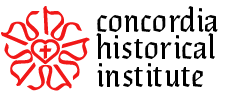August 16, 2013
Artifact: Sketch of the English Conference of 1872
Date: possibly 1947
Significance: The sketch is an artist’s (Wm. M. Lawson of Chicago) conception of the free conference that was held August 16-20, 1872, in Gravelton, Missouri. At this conference, the English Lutheran Conference of Missouri was organized. This organization was the precursor to the English Evangelical Lutheran Synod of Missouri and Other States (1891), which joined the Missouri Synod in 1911 as the English District. This sketch appeared (possibly for the first time in print) in The Lutheran Witness: English District Edition on August 12, 1947, in an article celebrating the seventy-fifth anniversary of the free conference. Dr. C. F. W. Walther (right) is shown preaching from a wagon, Rev. Jonathan Moser (middle) stands translating Walther’s words into English, and Rev. Polycarp C. Henkel (left), the pastor at Zion Lutheran in Gravelton where the conference was held, is also pictured.
Firsthand Account of Walther at the Conference: In the seventy-fifth anniversary article in 1947, Mrs. Belle Johnson, granddaughter of one of the charter members of Zion, was quoted recalling the German service during which Walther preached along with the sessions of the conference. Johnson was 82 at the time and had attended the conference as a child. She recounted the following:
When Walther preached he stood in the back of a buckboard wagon with a brush arbor over him for shade. This latter, I believe, was improvised by sympathetic souls who wanted to keep him as cool as possible. He preached in a Prince Albert coat and we were all gathered outside the old meeting house, because there was no room within and it was cooler outdoors. We children sat on oak slab benches laid across short logs and the men and women sat apart.
Excerpt from Fred C. Stein and H. William Lieske, “A Description of the Cradle of the English District, After Seventy-Five Years,” The Lutheran Witness: English District Edition 66 (12 August 1947).
About the Conference: The free conference was held at the request of Polycarp C. Henkel and Jonathan R. Moser, both of Gravelton, Missouri. They invited men from other Lutheran synods in Missouri to the conference with the intent to advance the English Lutheran Church in the West. Participants included Henkel, Moser and six laymen from the Tennessee Synod; Rev. Andrew Rader and three laymen of the Holsten Synod; Prof. C. F. W. Walther and Rev. C. S. Kleppisch of the Missouri Synod; Prof. F. A. Schmidt of the Norwegian Synod; and other attendees from miles around. Walther presented sixteen doctrinal theses along with the reasoning for them from the Lutheran Confessions. He spoke in German when presenting the theses, and Moser translated his words into English for the attendees. Schmidt, Walther, Kleppisch and Rader all preached at some point during the conference. Walther preached a service in German on the Sunday morning of the conference to the few German-speaking Lutherans in the area, while the other three all preached their sermons in English. Walther gave a recap of the conference in the next issue of Der Lutheraner. He stated that the meeting concluded with a need to get more English pastors, possibly an English student at the seminary and a constitution for the newly organized English Lutheran Conference of Missouri. He concluded his article with the following blessing on this new endeavor:
May God grant His gracious blessing upon this small and promising beginning of providing for the English-speaking children of our Lutheran Church who are scattered here in the West. Every one of us who love Zion should pray down the Heavenly Father’s mercy upon this work of our church. Amen!
Excerpt from Der Lutheraner 28 (1 September 1872), as translated in Fred C. Stein and H. William Lieske, “A Description of the Cradle of the English District, After Seventy-Five Years,” The Lutheran Witness: English District Edition 66 (12 August 1947).



